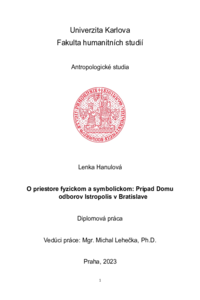O priestore fyzickom a symbolickom: Prípad Domu odborov Istropolis v Bratislave
On physical and symbolic space: The case study of the House of Trade Unions Istropolis in Bratislava
O prostoru fyzickém a symbolickém: Případ Domu odborov Istropolis v Bratislavě
diplomová práce (OBHÁJENO)

Zobrazit/
Trvalý odkaz
http://hdl.handle.net/20.500.11956/188126Identifikátory
SIS: 249933
Kolekce
- Kvalifikační práce [6878]
Autor
Vedoucí práce
Oponent práce
Zandlová, Markéta
Fakulta / součást
Fakulta humanitních studií
Obor
Antropologická studia se specializací Sociokulturní antropologie
Katedra / ústav / klinika
Program Antropologická studia
Datum obhajoby
30. 1. 2024
Nakladatel
Univerzita Karlova, Fakulta humanitních studiíJazyk
Slovenština
Známka
Dobře
Ak je priestor mesta spoločensky vytváraný, možno tvrdiť, že na symbolickej úrovni predstavuje spoločenské prostredie na danom území a v danom čase (Lefebvre, 1991). V tomto ohľade by teda malo platiť, že ak sa zmenia názory spoločnosti, dominantné naratívy alebo diskurz, zmení sa aj fyzická podoba mesta a naopak. Je práve toto dôvod pre ktorý musel byť aj bratislavský Istropolis zbúraný? Táto práca preskúmava správnosť týchto predpokladov v prípade socialistického modernizmu v architektúre postkomunistického regiónu, konkrétne na príklade budovy Istropolisu v Bratislave. Hoci sú socialistické modernistické budovy architektonicky hodnotné, často sa považujú za škaredé alebo sa dokonca búrajú ako nežiaduce. Aká je dynamika, ktorá vedie k takémuto diskurzu a konaniu? Sú takéto budovy skutočne "škaredé" a nežiaduce? Ak áno, prečo? Akú úlohu v tomto vnímaní zohráva ideológia? Kľúčové slová: paláce kultúry, architektúra, socialistický modernizmus, ideológia, kultúra, kultúrnosť, hodnota
English title: About physical and symbolic space: The case of the Istropolis Trade Union House in Bratislava Abstract: If the space of the city is socially produced, it can be argued that at a symbolic level it represents the social environment in a given territory and at a given time (Lefebvre, 1991). In this respect, it should therefore be true that if society's views, dominant narratives or discourse change, the physical form of the city also changes and vice versa. Is this the reason why Bratislava's Istropolis had to be demolished? This thesis examines the accuracy of these assumptions in the case of socialist modernism in the architecture of the post-communist region, specifically using the example of the Istropolis building in Bratislava. Although socialist modernist buildings are architecturally valuable, they are often considered ugly or even demolished as undesirable. What are the dynamics that lead to such discourse and action? Are such buildings really "ugly" and undesirable? If so, why? What role does ideology play in this perception?
